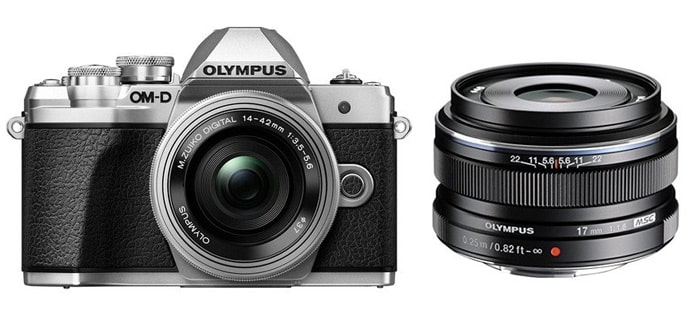The new Olympus OM-D E-M10 III is a fantastic, compact camera with great features. You’ve got a 16MP sensor, with 4K video recording and 8.6 frames per second.
With such a good camera, you’ll need some good Olympus lenses if you want to get the most out of it. There are plenty of options available, for all types of photography (sports, landscape, portraits, travel, wildlife etc.)
It’s the lenses that take your photography to the next level. What you get in the kit is usually okay for normal stuff, but if you want better image quality, sharpness, background blur and more, it’s all about the lenses. Your skills do matter of course, but there’s no denying that lenses are the most important gear factor.
This guide is perfect whether you’re a complete beginner, or a more advanced user. We went through all Olympus lenses, and chose the best 11 for your Olympus OM-D E-M10 III.
Best Lenses for Olympus OM-D E-M10 III:
Olympus M. Zuiko 12mm f/2
Olympus M. Zuiko 17mm f/1.8
Olympus M. Zuiko 25mm f/1.8
Olympus M. Zuiko 45mm f/1.8
Olympus M. Zuiko 60mm f/2.8 Macro
Olympus M. Zuiko 75mm f/1.8
Olympus M. Zuiko 7-14mm f/2.8 ED PRO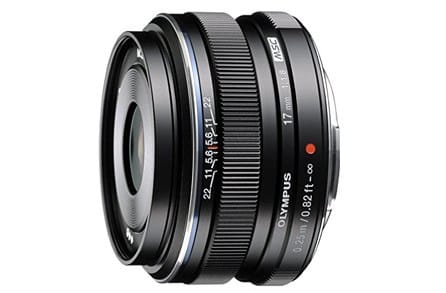
Olympus M. Zuiko 12-40mm f/2.8 PRO
Olympus M. Zuiko 12-100mm f/4 PRO
Olympus M. Zuiko 40-150mm f/2.8 PRO
Olympus M. Zuiko 40-150mm f/4-5.6 R
If you decide to buy anything after clicking on our Amazon links, you automatically support us. It’s what allows us to write guides such as this one.
1. Olympus M. Zuiko 12mm f/2
Best for landscape, travel and astrophotography
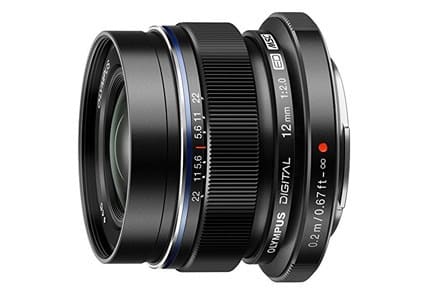
The Olympus M.Zuiko 12mm f/2 is a premium quality wideangle lens for the E-M10 III offering excellent image definition coupled with sturdy construction. Equivalent to a 24mm focal length in the 35mm format, the M. Zuiko 12mm is well suited to landscape and sky photography. However, thanks to its great manual focus features, rugged weather-sealing, and a durable all-metal build, it clearly also begs to be used for travel and candid street shots.
Olympus’s advanced still and movie compatible auto focus system guarantees you won’t miss a moment, while excellent image stabilization rules out camera shake. Pulling the focus ring backwards instantly switches the lens to manual focus mode and simultaneously reveals a clear distance scale. This feature makes it simple to set focus at a predetermined distance, in order to rapidly capture subjects “from the hip”.
The lens does not suffer from any noticeable color aberrations and only at the widest of apertures does some slight blurring become detectable in the corners. What’s more, lens flare and ghosting have largely been eliminated thanks to Olympus’s low-reflection “ZERO” lens coating.
Featuring a rounded seven-blade diaphragm, this lens produces pleasing bokeh when used wide open. However, at 12mm this will never be your first choice of lens for portraiture. Instead, with such a wide field of view, the 12mm f/2 is better suited to fast shooting in crowds, or capturing sweeping vistas of either the night sky or more terrestrial landscapes.
You can buy it at Amazon or see more reviews here.
2. Olympus M. Zuiko 17mm f/1.8
Best for travel, casual daily photography, portraits and low light

The Olympus M. Zuiko 17mm f/1.8 is a discrete and fast lens for use with all Olympus Micro Four Thirds cameras. Boasting excellent optics and weighing just 4.23 oz/120g, it’s a great choice for everyday shooting. Fast maximum aperture, silent AF, and compact dimensions also make it well suited to unobtrusive documentary and snapshot photography in low light conditions.
At 17mm, focal length is equivalent to a 34mm lens in the 35mm format. I.e. field of vision is moderately wide, but not so wide that you must be standing on your subject’s toes in order to frame their face large in the shot. Housed in a solid, stylish, all-metal casing, optical quality is identical to Olympus’s “premium” 12mm f/2 lens, producing ultra sharp, high contrast images from f/1.8 through to f/22.
The 17mm also comes with the same handy AF/MF focus selection mechanism as its wider sibling. This allows you to rapidly snap the lens into manual mode, estimate distance, and then quickly set focus and fire off a shot before the subject is even aware. Very useful for photographing in low light. Silent auto focus makes the 17mm well suited for video too.
Besides portraits, this is a great lens for travel and everyday situations, including street photography. As a matter of fact, 35mm is the focal length that’s most commonly used for street shots. If you’re looking for your first E-M10 III lens, this or the one below would be great to start (or both honestly).
You can buy it at Amazon or see more reviews here.
3. Olympus M. Zuiko 25mm f/1.8
Best for traveling, portraits, casual day photography, events
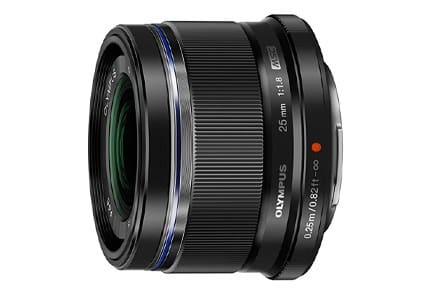
The Olympus M. Zuiko 25mm f/1.8 is a must have for any photographer! It is an excellent choice for portraits, documentary, weddings and more general everyday shooting. Thanks to f/1.8, it also offers top low-light performance for those on a budget. Small, lightweight, and featuring Olympus’s ZERO lens coating for sharper rendering, this is a great little lens that is also particularly suited to travel photography, where compact size and versatility are real advantages.
As with Olympus’ similar but more expensive 25mm f/1.2 PRO lens, the f/1.8 is sturdily built and extremely sharp even wide open. While bokeh is perhaps not as smooth as with the f/1.2, it’s nonetheless impressive thanks to a seven-blade diaphragm. Sadly though, the f/1.8 does not feature the “snapfocus” ring for manual focus that has now become pretty much standard with many of the more expensive M. Zuikos.
If you’re looking for your first lens, or just something better than the one you got with your camera, this is where you should start. This is an inexpensive way to enter a more professional world and really make a big difference in your pictures. Aperture f/1.8 allows you to make your subject stand out and make the colors look rich, and also to shoot in low light. No more blurred indoor birthday/party/event shots, and no need for a flash anymore.
While at f/1.8 this is already a relatively fast lens, its much more expensive f/1.2 PRO sibling of course offers the ability to shoot in even lower light, and with a shallower depth of field. Optically, though, there’s little to differentiate between the two lenses, and the f/1.8 has the advantage of being considerably smaller. The only other major difference between these two primes is that the f/1.2 is weather-sealed, whereas this one is not. This means that if you can live without the extra stop of light and the all-weather durability offered by the f/1.2 PRO lens, the f/1.8 is a great buy. Since the E-M10 III is not sealed, and the f/1.2 is also heavier, it’s probably not the go-to choice for the camera. Nothing beats the 25mm f/1.8.
You can buy it at Amazon or see more reviews here.
4. Olympus M. Zuiko 45mm f/1.8
Best choice for portraits, concerts, low light and weddings
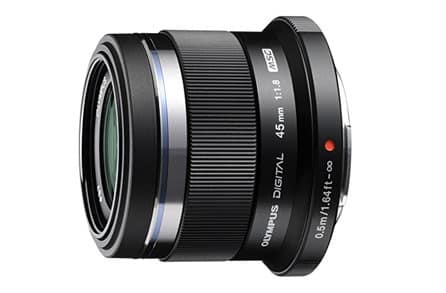
If you are looking for a fast, compact and lightweight lens for the E-M10 III, the Olympus M. Zuiko 45mm f/1.8 makes for a convincing choice. Equivalent to a 90mm lens in the 35mm format, this is widely considered to be an ideal focal length for portraiture, concerts and weddings, allowing you to isolate a subject from their surroundings. What’s more, the bright f/1.8 aperture permits shooting in low light and lets you achieve the shallow depth of field and blurred background that is so desirable in portrait photography.
The 7 blade circular diaphragm makes for smooth, rounded bokeh, and Olympus’s ZERO lens coating helps keep ghosting and flare to a minimum, even when pointing directly into the light. Indeed, the lens generally performs very well in high contrast situations, retaining excellent sharpness and detail.
Although a nearest focusing distance of 50cm may not sound especially close, on a 45mm lens this is more than sufficient for shooting tightly-framed portraits. Fast, snappy and silent auto focus makes the 45mm a similarly good choice for head-and-shoulder video interviews, or other movie scenarios where a close-crop is desirable. Weddings, events, concerts, you name it; the length is ideal for these.
The 45mm f/1.8 comes in a rugged black or chrome metal barrel. However, despite being one of Olympus’s “premium” lenses, it is sadly missing the fast-select manual focus ring of other lenses in the same series. More surprisingly still – for a lens billed as “premium” – is that the 45mm lacks weather-sealing.
It’s ideal for concerts, weddings, portraits or any other situation where you can’t be close to your subject. 45mm (equivalent to 90mm) is quite long, but thankfully the Olympus OM-D E-M10 II has built in stabilization.
You can buy it at Amazon or see more reviews here.
5. Olympus M. Zuiko 60mm f/2.8 Macro
Great for bugs, portraits and small items/studio photography
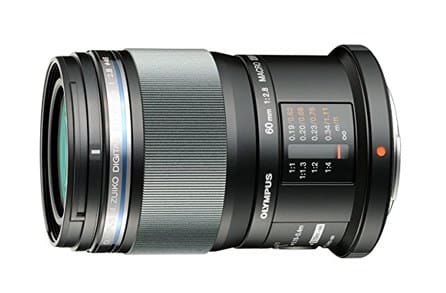
As its name would suggest, the Olympus M. Zuiko 60mm f/2.8 Macro is a lens designed specifically with macro photographers in mind. However, beyond shooting extreme close-ups of the natural world, this is actually a very useful piece of glass for everything from product shots to portraits, and even the occasional creative landscape.
Equivalent to a 120mm lens in the 35mm format, image magnification is 1:1. Sharpness is great across the image, while ghosting, double-line defocusing, and color aberrations are kept under control by Olympus’s ZERO lens coating. This also helps considerably to eliminate spot flare (i.e. flare shaped like the aperture blades) when shooting against the light, making the 60mm f/2.8 an excellent choice for jewelry and product photography – especially when photographing back-lit products for e-commerce.
A focal length of 60mm is also ideal for portraits, particularly head shots, allowing you to totally isolate the subject from the background.
Despite its versatility for more general use, Olympus has sought to make this a highly convenient lens for macro photography. For example, Focus Limit permits you to narrow down the field of focus to one of four settings: 1x, Close-Up, Normal, and Landscape. This massively improves AF performance by restricting focus to a narrower range: no more focus-skipping between the extremes of background and foreground.
Finally, the lens is dustproof and splashproof, making it a practical choice for use “in the field”.
You can buy it at Amazon or see more reviews here.
6. Olympus M. Zuiko 75mm f/1.8
Great for long portraits, sports and events
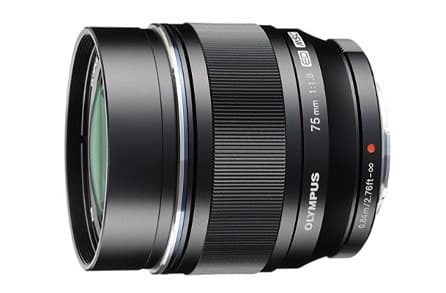
Marketed by Olympus as a “high-grade portrait lens”, the Olympus M. Zuiko Digital ED 75mm f/1.8 is a sharp, well-made piece of glass offering a longer-length alternative to more traditional choices for portraiture. However, owing to it’s excellent auto focus and fast maximum aperture, this is also a lens that could be put to good use shooting nature, wildlife, concert, theater and sports photography.
Equivalent to a 150mm lens in the 35mm format, the 75mm f/1.8 exhibits excellent sharpness across the entire image area and throughout all aperture settings. Olympus’s ZERO lens coating helps to keep flare, ghosting and aberrations at bay – even when shooting in high contrast or backlit conditions – and the lens renders out of focus areas of the image beautifully. Indeed, pleasing circular bokeh and feathered edges further boost the 75mm’s portrait lens credentials. Nearest focusing distance is 84cm, which at this degree of magnification makes for some intensely close-up portraits.
Auto focus with the 150mm is fast and silent, owing to Olympus’s gearless MSC (Movie and Still Compatible) focus mechanism. The lens features solid metal construction in either silver or black, with a nicely grippable manual focus ring. On the downside, this is a fairly costly lens, and unlike the more standard 60mm portrait lens, 75mm is not a focal length that will appeal to all users. Additionally, despite the price, the lens is not weather sealed.
You can buy it at Amazon or see more reviews here.
7. Olympus M. Zuiko 7-14mm f/2.8 ED PRO
Best wide angle zoom for landscape, travel, indoors and astrophotography
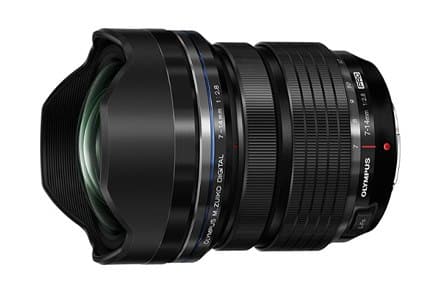
The Olympus M. Zuiko ED 7-14mm f/2.8 PRO lens is an excellent ultra wideangle zoom lens for the Micro Four Thirds format. Despite being relatively lightweight, the lens is satisfyingly solid, ruggedly built and weather sealed. Meanwhile, hermetic sealing keeps it protected when shooting in difficult terrain. Its wide field of view, sharp optics and constant fast aperture of f/2.8 throughout all zoom settings makes this an ideal lens for landscapes, interiors, night sky photography, and street shooting.
Equivalent to a 14-28mm lens in the full frame 35mm format, this is the only wide angle lens you will really need. There is a little softness detectable at the image corners, and some flare is still occasionally present when shooting into the light, but there’s no noticeable ghosting or color aberrations and overall this is an extremely crisp, high resolution lens. What’s more, Olympus’s ZERO Coating means that the lens performs well even under challenging conditions, such as when pointing directly towards a strong light source.
With the addition of Olympus’s separately available waterproof housing, this lens can be used underwater for shooting spectacular wideangle sub-aqua seascapes. Pair the 7-14mm with its 12-40mm f/2.8 PRO sibling, and you are prepared for almost any photographic situation conceivable.
You can buy it at Amazon or see more reviews here.
8. Olympus M. Zuiko 12-40mm f/2.8 PRO
Best general zoom, perfect for almost everything but wildlife
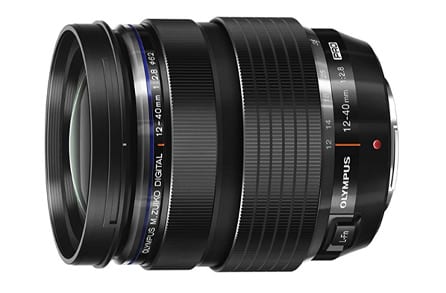
The Olympus M. Zuiko ED 12-40mm f/2.8 PRO is a great all-purpose, go-to lens for daily use. It is part of Olympus’s range of constant aperture f/2.8 “PRO” zoom lenses for the Micro Four Thirds format, covering everything from 7mm through to 300mm. It’s weather sealed (dust and splash proof), and ruggedly built to withstand the rigors of professional use, this is pretty much the only lens you need: regardless of the genre of photography you shoot, the 12-40mm f/2.8 PRO will have you covered.
As with many lenses in this series, the 12-40mm features Olympus’s signature manual focus “clutch” selection ring, allowing you to quickly switch between AF and MF modes without taking your eye off the subject. Selecting manual mode provides excellent control by means of a satisfying grip, and there are stops at either end of the focus range.
The lens also has a custom function button, to which you can assign any one of many tasks, to quickly switch between preferred shooting modes. Indeed this is a lens designed for ease of use. And while for a similar price you could purchase two separate primes covering the two extremes of the 12-40mm’s focal range (35mm equivalent: 24-80mm) – this wouldn’t provide the same degree of flexibility as the zoom.
Unusually for a zoom, there appears to be no compromise on image quality: Olympus’s ZERO coating has pretty much done away with ghosting and aberrations altogether, and keeps flare to a minimum. If you’re less in need of a fast aperture and more interested in a convenient, all-in-one, solution, consider the 12-100mm f/4 IS PRO instead.
You can buy it at Amazon or see more reviews here.
9. Olympus M. Zuiko 12-100mm f/4 PRO
Best all-in-one travel zoom for landscape, indoors, streets and daily photography
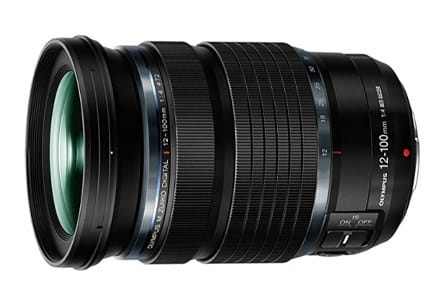
The Olympus M. Zuiko ED 12-100mm f/4.0 IS PRO is a great all-round workhorse for those less concerned with fast glass and more in need of a single dependable lens they can take everywhere. If you’re the kind of photographer who strives to get each image crystal sharp from background to foreground, it’s likely that you rarely ever shoot with the diaphragm at wider settings anyway. Offering an enormous choice of focal lengths in one single compact and portable zoom, this a great solution for landscape shooters who don’t want to be weighed down by a bag full of heavy prime lenses as they trek off into the wilderness.
If you’ve used any of the other lenses in Olympus’s PRO series, you’ll know that the optics are generally top notch. That’s also the case here, despite the wide range of magnification that the 12-100mm has to deal with. Providing equivalent coverage to a 24-200mm lens in 35mm format, it is nonetheless surprisingly compact, especially when compared to a similar setup on a full frame DSLR.
The barrel is of sturdy metal construction and is hermetically sealed against the elements. It also features Olympus’s signature manual focus snap selection ring and comes with a well-designed and securely-fastening lens hood that will not fall off as you pull the lens out of your bag.
Admittedly the 12-100mm is not cheap. But who would expect a professional lens to be cheap anyway? It’s still likely less expensive than a set of primes to cover an equivalent range of focal lengths. For those in need of a wider maximum aperture than this can provide, Olympus’s 12-40mm f/2.8 PRO is the lens to look at.
You can buy it at Amazon or see more reviews here.
10. Olympus M. Zuiko 40-150mm f/2.8 PRO
Best telephoto zoom for anything indoors or outdoors; sports, portraits, events, weddings, etc.
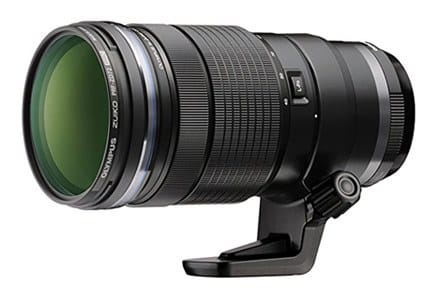
The Olympus M. Zuiko 40-15mm f/2.8 PRO is an obvious choice for portraiture, stage, sports and wildlife photography. With a constant aperture of f/2.8 at all zoom settings, this a fantastic solution for photographers who frequently need to shoot in low light but who don’t wish to compromise on either portability or image quality.
Equivalent to an 80 to 300mm lens in the 35mm format, the 40-150mm f/2.8 PRO allows you to get right into the heart of the action. And super fast auto focus means you’re unlikely to miss a shot when you do. Present, too, is the ever popular AF-MF clutch ring, allowing you to quickly switch between focus modes while shooting.
The lens is also very well suited to producing portraits, with beautiful circular bokeh backgrounds, and at a wide range of focal distance settings. Olympus’s ZERO lens coating keeps flare and ghosting well contained, and purple fringing is minimal. Image sharpness at the corners is excellent, while at the center it’s outstanding.
The sturdily built lens barrel features a user-assignable custom function button, and a twist-and-slide extendable lens hood. What’s more, as it’s splashproof, freezeproof, and dust proof, this is a lens you can rely on. This is a lens you buy and use forever, for anything; a true workhorse. It’s not as small or light as the rest of our choices, so consider this because it will make your system a lot less compact. If you use your E-M10 III to travel as light as possible, consider our option below.
You can buy it at Amazon or see more reviews here.
11. Olympus M. Zuiko 40-150mm f/4-5.6 R
Budget telephoto for outdoor photography; wildlife, sports and races

Want a telephoto lens under $150 that’s also very compact? With fast auto focus and excellent resolution for the low price, the Olympus M. Zuiko Digital ED 40-150mm f/4-5.6 R zoom lens makes for a much more affordable alternative to the brand’s 40-150mm f/2.8 PRO lens. Offering coverage equivalent to 80-300mm (35mm format), this is a great lens for isolating a subject against a background, or for capturing action from a distance. It will be of interest to sports and nature enthusiasts, as well as portrait and performing arts photographers. Similarly, silent auto focus means it’s an equally good choice for video.
There’s no flare, purple fringing, or other chromatic aberrations, and in this respect the budget 40-150mm actually stands up very well when compared to even quite expensive Zuiko lenses. Image sharpness towards the center of the frame is also excellent. However, corners are notably softer than with top of the range Olympus glass. Likewise, if smooth rendering of defocussed areas is a priority, you’ll need to consider other options: bokeh is harsh, with noticeable double-edging.
While the f/4-5.6 R may be at the budget end of Olympus’s telephoto range, optically it holds up well and is conveniently light and compact. Nonetheless, build quality is clearly not on a par with that of its PRO series cousins. Likewise, for those who do a lot of low light shooting, the constant aperture f/2.8 PRO will be a much more practical choice than the relatively gloomy maximum aperture of f/4-5.6 that this lens can muster.
For outdoor wildlife, races and sports (or also indoors, but you have to raise the ISO), this is the perfect lens. It’s lightweight, easy to use and gets you close to your subject.
You can buy it at Amazon or see more reviews here.
Best Lenses for Olympus OM-D E-M10 III:
Olympus M. Zuiko 12mm f/2
Olympus M. Zuiko 17mm f/1.8
Olympus M. Zuiko 25mm f/1.8
Olympus M. Zuiko 45mm f/1.8
Olympus M. Zuiko 60mm f/2.8 Macro
Olympus M. Zuiko 75mm f/1.8
Olympus M. Zuiko 7-14mm f/2.8 ED PRO
Olympus M. Zuiko 12-40mm f/2.8 PRO
Olympus M. Zuiko 12-100mm f/4 PRO
Olympus M. Zuiko 40-150mm f/2.8 PRO
Olympus M. Zuiko 40-150mm f/4-5.6 R
Last Updated on September 14, 2021 by Nick Voorhees
First and foremost, I’m a husband and father. Then professionally I’m photographer, designer, blogger, and Esty store owner. My homebase is near the stunning Wasatch mountains in Utah but I love traveling with my family as part of our homeschooling journey. I also love teaching and helping out others. My faith is one of the biggest aspects of my life and brings be a consistent joy that I haven’t found in anything else. My main blog is BestPhotographyGear.com and I strive to make photography simple for anyone looking to learn or find gear for their individual needs. By nature, I like to study, research, and analyze things and I use that help provide the best advice and reviews I can.

